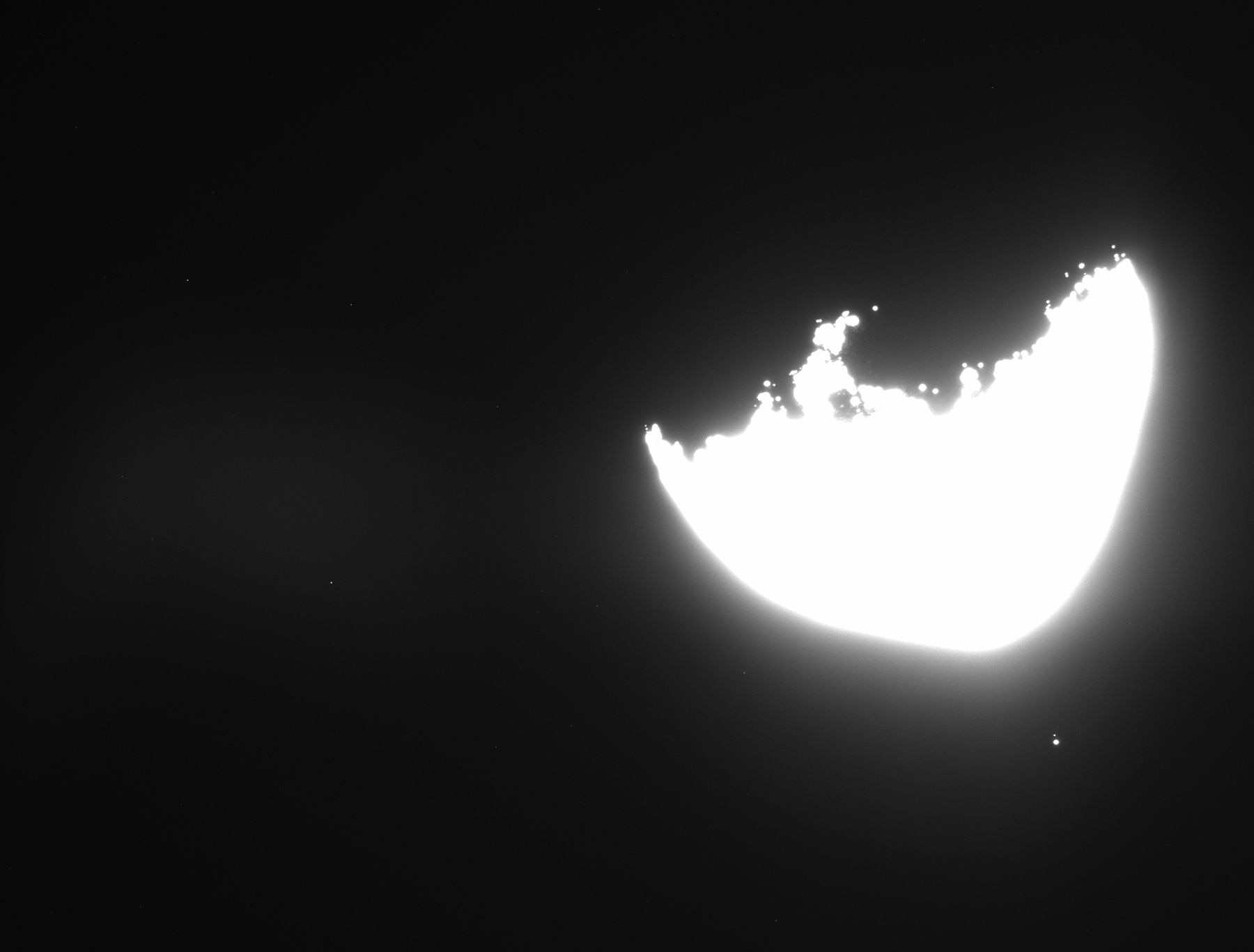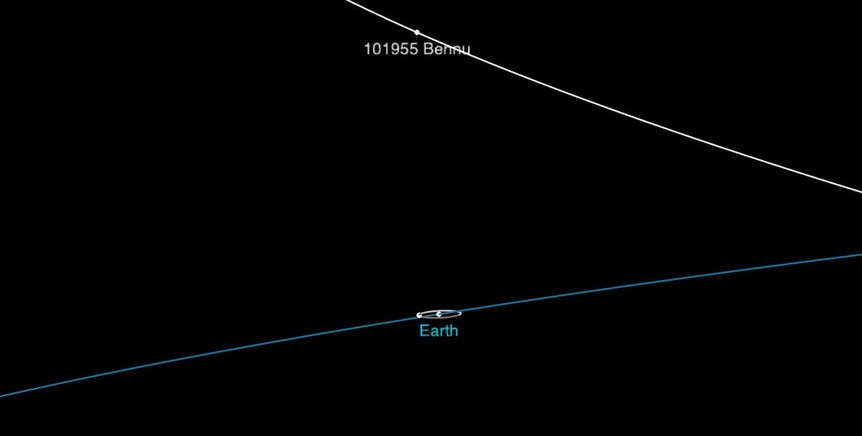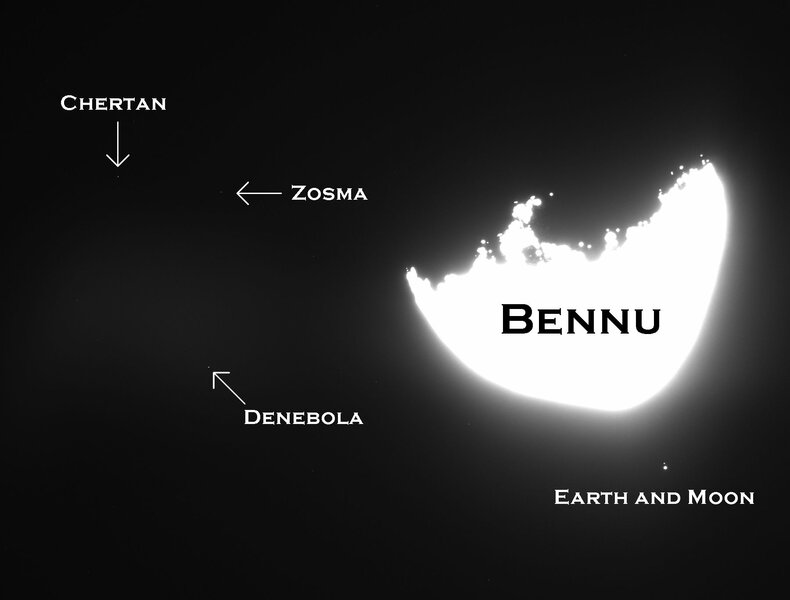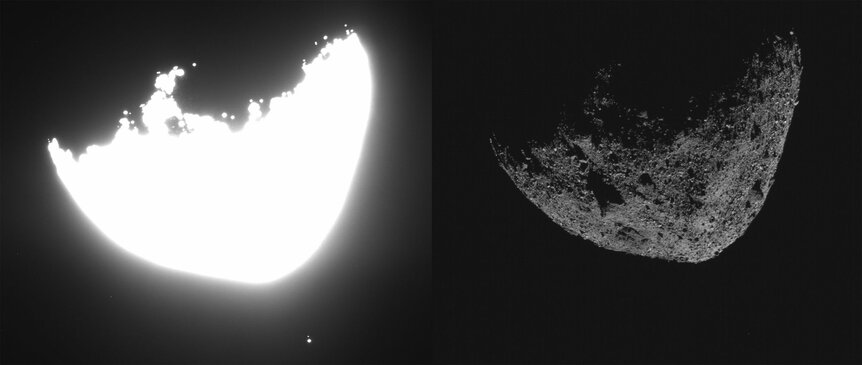Create a free profile to get unlimited access to exclusive videos, sweepstakes, and more!
OSIRIS-REx sees Earth from 100 million kilometers away

The OSIRIS-REx spacecraft has been orbiting the wee asteroid Bennu for nearly a year now. It’s been mapping the asteroid’s surface, taking a measure of its gravity to get its mass, proven it’s a rubble pile, has seen it bizarrely spitting rocks into space, and has been scoping out a place to briefly touch the surface long enough to collect some samples to eventually return to Earth. The mission so far has been a tremendous success.
As the spacecraft orbits, it takes lots of images from its various cameras, including the navigation camera, usually just called Navcam. This is a 5 megapixel camera with a very wide 44 x 32 degree field of view — on Earth, this would be a field of view over 80 times wider than the full Moon in the sky! It takes such wide-angle shots because those are used for navigation; it can see down to relatively faint stars and use those to figure out where it is and what its orientation is.
On 19 January, 2019, the Navcam took a long exposure of the sky — five seconds — when Bennu was in the field of view. The image is pretty amazing:
As you can see, Bennu is wickedly overexposed here. The sunlit part is just a blob, and near the terminator (the day/night division) you can see some spots where rocks are sticking up into the Sun. The ridiculously rough surface, strewn with rocks and boulders, makes the terminator pretty wonky-looking. From 1.7 kilometers away, Bennu, at 500 meters wide pole-to-pole, dominates the view.
But there is something else in the photo as well. To the left you can see some stars (more on them in a sec), and just below Bennu is a very bright star with a fainter one right next to it. See them?
Except … those aren’t stars. The bright one is Earth. The fainter one is the Moon!!!!
Yup. That’s us. That little blob of light is our entire planet, seen from a distance of just over 100 million kilometers away. You’re in that picture. So am I, and everyone you know, and everywhere you have ever been, and everywhere any human has ever been.
I first saw this image in Roman Tkachenko’s Twitter feed. He frequently posts spacecraft images that he has reprocessed, many with interesting animations or brightness stretches to show unusual features. He noted that this was the Earth and Moon in the image … and also slyly said this is what a target looks like to a potentially hazardous asteroid. He’s right.
I asked him where he got the data, because I wanted to poke at it. He shared, and so I used some astronomy software (called DS9, and yes, that’s on purpose) to take a look. As it happens, from Bennu’s point of view the Moon and Earth were about as far apart as they could be. That’s a fortuitous event, because it meant I could do a little math. Knowing how far away the Moon is, and how far OSIRIS-REx was from Earth, I could find the separation of the Earth and Moon from OSIRIS-REx’s position. I got 0.2°, about half the width of the full Moon in our sky. I also directly measured their separation in the image and got the same answer. That was satisfying.
I was also able to confirm this is in fact the Earth and Moon! I measured the coordinates of the Earth in the image (using Right Ascension and Declination, which are like longitude and latitude on the sky). I then looked up the coordinates of Bennu in our sky on that same date. What I found is that the two numbers were on almost exactly opposite parts of the sky. That’s precisely what you’d expect! It’s like looking at two points opposite each other on the Earth; the longitude separation will be 180°, and the latitude will be reflected across the equator (so if one point is at 10° north, the other will be at 10° south). That is just what I calculated, showing that this was indeed Earth. Again, satisfying. Math!
Back to those three stars to the left. At the time, Earth was in the constellation of Leo as seen from Bennu, which really does look like a lion lying down, seen from the side. There are three stars that make up its hindquarters. Could they be those?
Yup. Again, checking the coordinates of the stars, they turn out to be Beta, Theta, and Delta Leonis, aka Denebola, Chertan, and Zosma. Here is a labeled image to point them out:
Coooool. These are naked eye stars, and pretty distinctive. I always get a thrill seeing something in a spacecraft image I can recognize. And it’s odd to see them looking just like they do from Earth … as of course they must. OSIRIS-REx’s 100 million kilometers distance is nothing compared to the hundreds of trillions of kilometers to those stars!
Finally, I was curious about how overexposed Bennu is in that shot. So I looked at the raw image archive and saw another image taken within a few seconds of this one. This other image has a much shorter exposure time (0.001376 seconds, so about 1/700th of a second), and that means Bennu is exposed much better. Here they are side by side:
Ah, that’s better. You can see some of the boulders in the darker shot that are glowing in the longer exposure. Also, it looks bigger when overexposed, because more pixels have more light in them. Interestingly, I think you can see Earth in the second image, but it’s very faint. Can you spot it?
And one more thing: This isn’t the first time OSIRIS-REx has seen the Earth and Moon from space! It’s done this several times, including one from pretty close, one from farther out, and a third from 63 million kilometers away. Check those out. It’s interesting what can be seen of a planet from different distances, especially one we know so well. It really does give you a sense of what it would be like — looking at them in reverse order — if you were on a spaceship approaching Earth.
Someday humans will have this view on their own, without having to go through a robot proxy. Won’t that be something? I wonder how long it will be, and what effect that will have on our outlook. I hope a positive one, just like it is to see all of our planet, history, and population covered by a few overexposed pixels in a distant robot’s camera.


















